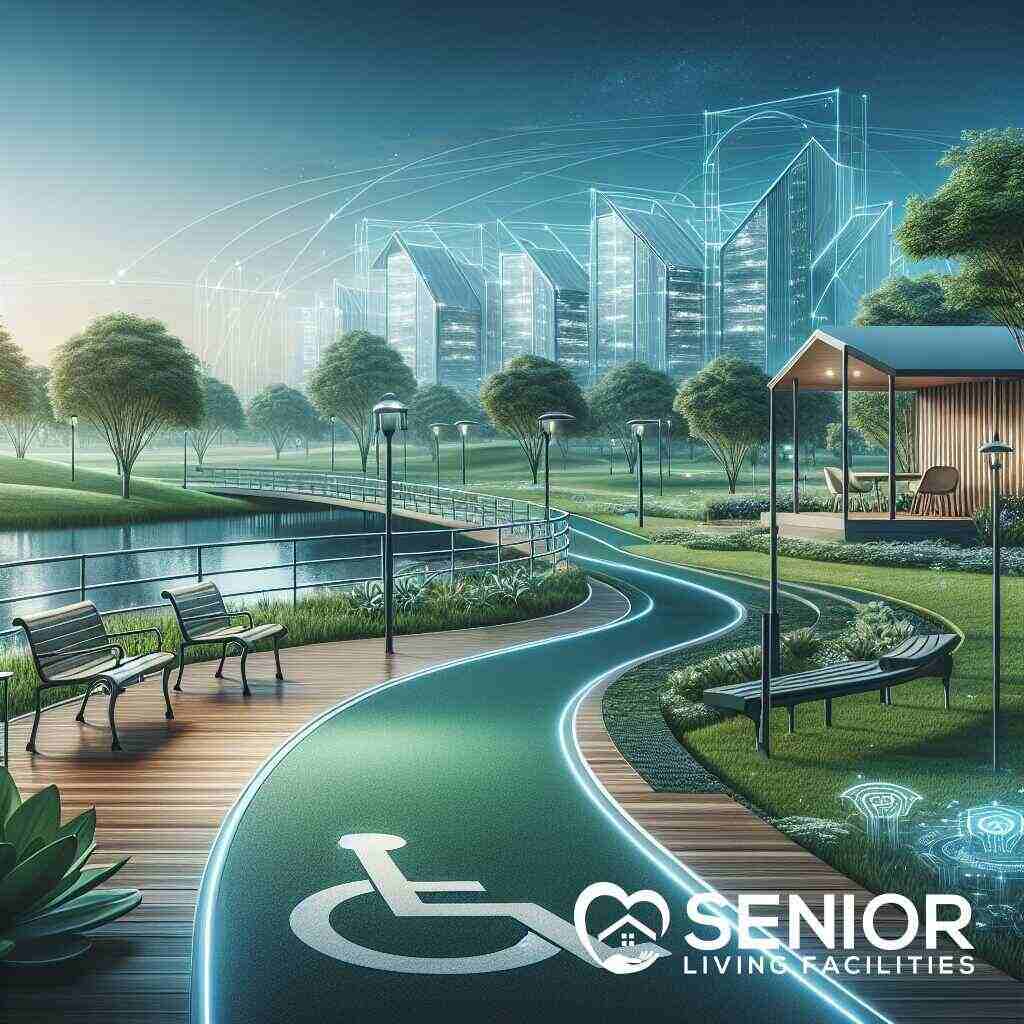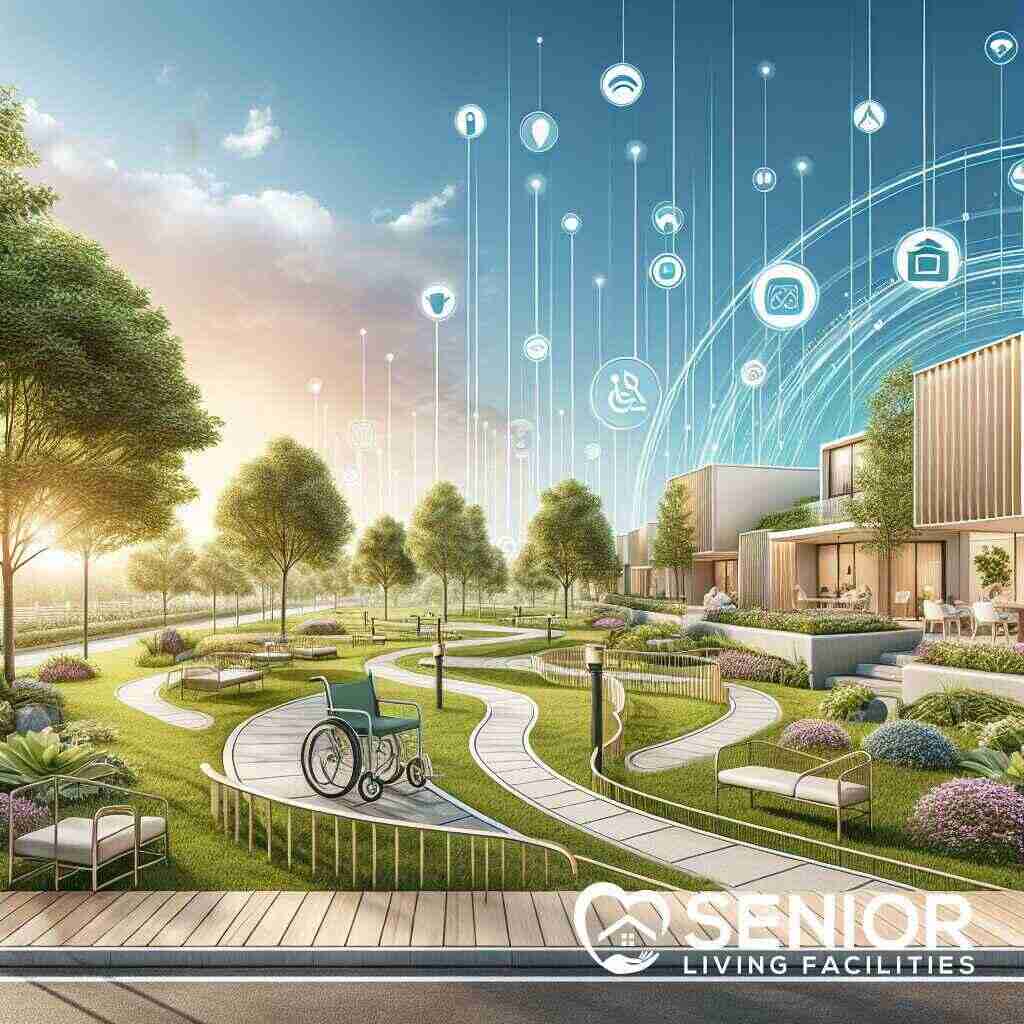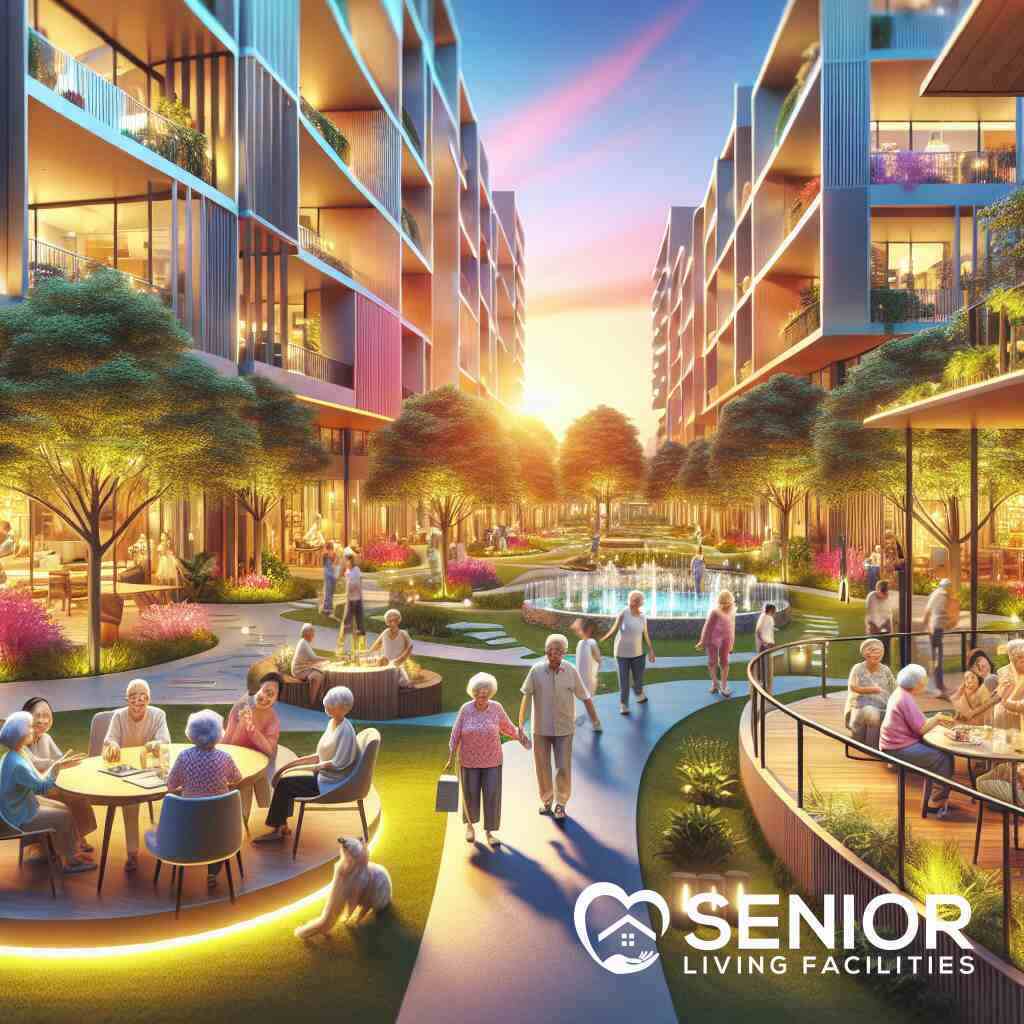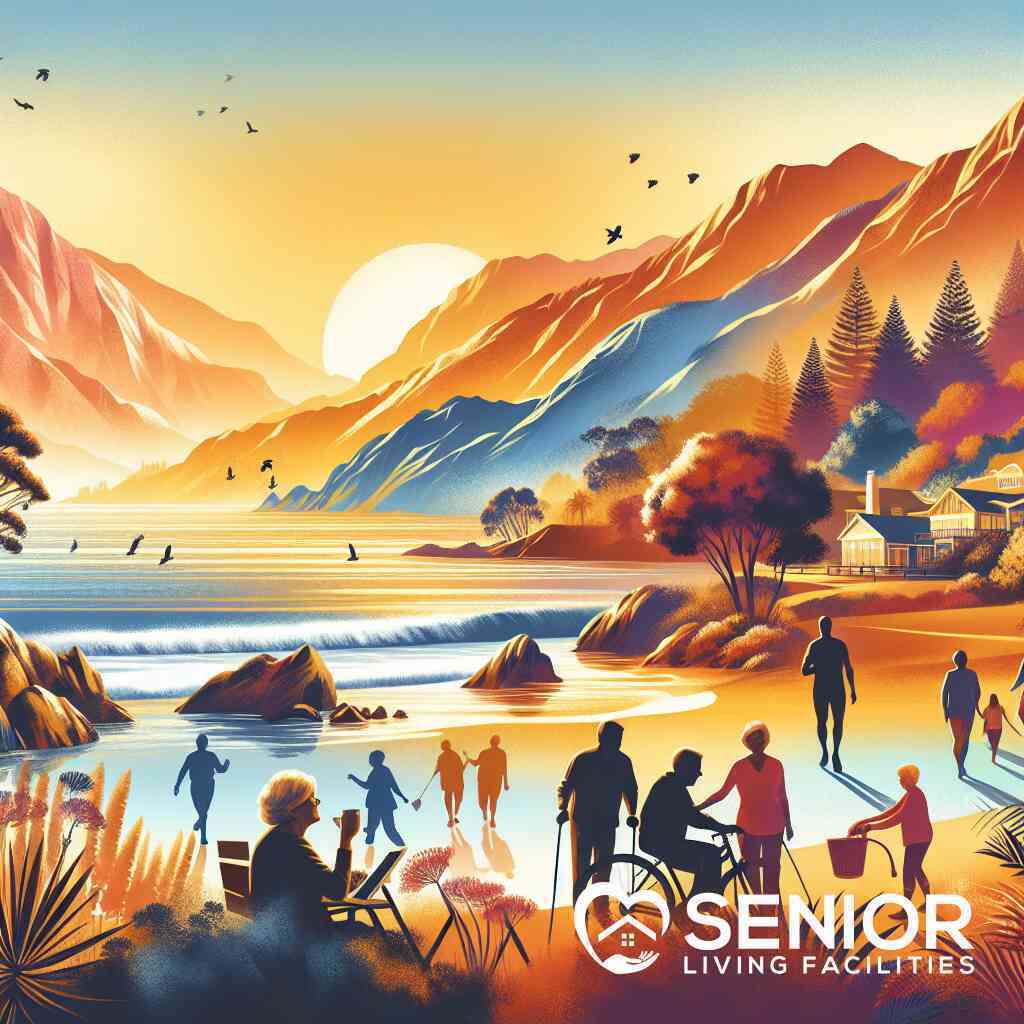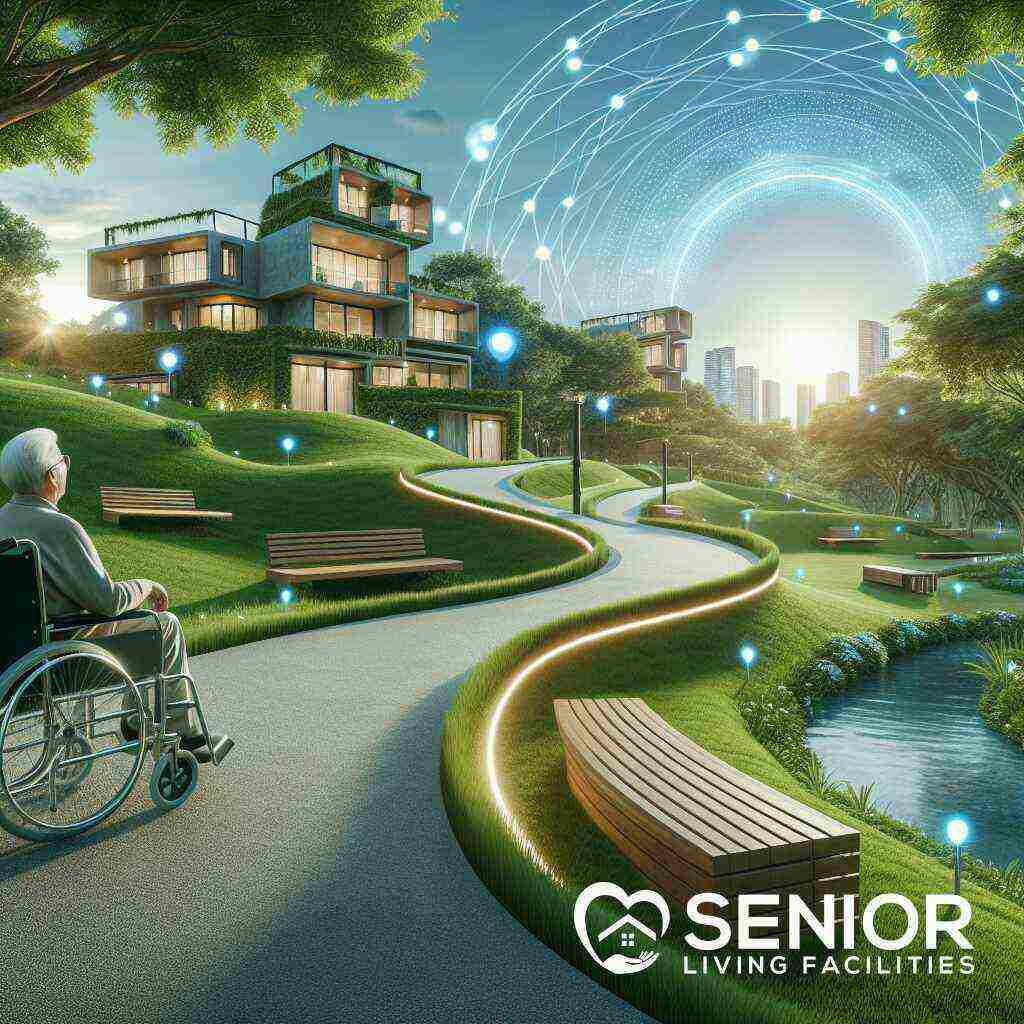
The Importance of Accessibility in Senior Living
June 4, 2024
Unlocking the Doors to Independence
The critical role of accessibility in senior living
Accessibility in senior living facilities is not just a matter of convenience, it’s a cornerstone of ensuring independence for seniors. As individuals age, their mobility may decrease, but their desire for independence and autonomy remains. Facilities that prioritize accessibility features not only cater to this essential need but also enhance the overall quality of life for their residents. Whether it’s through wheelchair-accessible design or the simple implementation of grab bars in restrooms, each aspect of accessibility plays a pivotal role in enabling seniors to navigate their living environment confidently and safely.
Understanding ADA compliance in elder care
The Americans with Disabilities Act (ADA) sets the benchmark for accessibility in public spaces, and its principles extend vehemently into the realm of elder care. ADA compliance in elder communities ensures that senior living facilities adhere to the standards that guarantee accessibility for all residents, regardless of their physical capabilities. From properly sized doorways for wheelchairs to accessible elevators and ramps, ADA-compliant facilities strive to remove physical barriers that can impede a senior’s ability to enjoy and fully utilize the amenities and services offered. Understanding these regulations is crucial for facilities aiming to offer an inclusive environment where every senior has equal access and opportunities.
The psychological impact of accessible environments on seniors
The design of a senior living environment has a profound impact not only on the physical well-being of its residents but also on their mental and emotional health. Living in a space that promotes independence through accessibility can greatly affect a senior’s self-esteem and overall happiness. The ability to perform daily tasks without assistance fosters a sense of achievement and satisfaction. Furthermore, accessible designs that encourage social interaction can alleviate feelings of isolation, promoting a more active and engaged lifestyle. By providing an environment that supports both the physical and psychological needs of seniors, facilities play a critical role in supporting their overall well-being.
Exploring Accessible Senior Living Facilities
Features of wheelchair-accessible senior living
Wheelchair-accessible senior living facilities are increasingly becoming a standard, not an exception. These facilities are designed with the utmost consideration for residents who utilize wheelchairs or mobility aids, ensuring they can live with as much independence as possible. Key features include wide doorways, ramp access at all entry points, wheelchair-accessible elevators, and roll-in showers. Spaces are carefully planned to allow for easy navigation, with enough room for turning and maneuvering wheelchairs. In such environments, seniors can access all the amenities and services the community offers without barriers, promoting a sense of inclusion and enhancing their quality of life.
Kitchens in these apartments are also modified with lower countertops and sinks, making meal preparation more manageable. Additionally, emergency call systems are within reach from the floor in case of falls, ensuring swift assistance. The goal of these design elements is to make daily tasks not just possible but comfortable for all residents, acknowledging the diverse needs of a community’s population.
Navigating senior living with disability support
Navigating through the options of senior living with disability support requires understanding the various levels of care and support available. Communities that focus on disability support go beyond mere physical structure adjustments, they encompass comprehensive care plans tailored to individual needs, including activities for daily living support, from dressing and bathing to medication management and health monitoring. Staff in these communities are specially trained to assist with mobility challenges and to understand the nuances of various disabilities, ensuring residents receive respectful and competent care.
This level of customization in care and support fosters a nurturing environment, where every individual’s needs are meticulously catered to, enabling them to maintain their dignity and independence. Occupational and physical therapy services are often available on-site, offering convenient access to essential health services. Social and recreational activities are designed to be inclusive, ensuring residents with disabilities have equal opportunities to engage and participate in community life.
Key differences in accessible senior housing options
The landscape of accessible senior housing presents a spectrum of options, each designed to cater to different levels of mobility and care needs. Independent living communities, for example, offer accessible living spaces and communal areas but are ideal for seniors who require minimal day-to-day assistance. On the other hand, assisted living plans provide more comprehensive support in daily activities, suitable for individuals who value their independence but need a higher level of care.
Skilled nursing facilities represent another tier, offering round-the-clock clinical care for seniors with significant health and mobility challenges. Finally, continuing care retirement communities (CCRCs) offer a tiered approach to accessibility, allowing residents to transition between different levels of care as their needs change over time, all within the same community. This continuum of care ensures that seniors can age in place, with their changing health and mobility needs adequately met.
Understanding these differences is crucial for families and seniors when selecting the most appropriate senior living arrangement. Each option is designed with the objective of maximizing independence and quality of life, regardless of an individual’s level of mobility or health status.
Designing for Life: Universally Designed Senior Living
Principles of universal design in senior communities
Universal design in senior communities recognizes the diversity of elderly individuals and aims to create environments that are accessible, understandable, and usable to the greatest extent possible, regardless of age, size, ability, or disability. At the heart of universal design in senior living is the acknowledgment that features benefiting individuals with disabilities also improve the space for everyone. This includes wider doorways that not only accommodate wheelchairs but also help residents using walkers or even those moving furniture. The principles extend to having no-step entryways, one-floor living options, and controls that are easily operable by all users. These inclusive design elements ensure that residents can enjoy their living spaces with greater ease and independence, fostering a community that adapts to their changing needs over time.
Creating a universally designed senior living community involves considering every aspect of the residents’ lifestyle-from the location of electrical outlets to the types of door handles used. By implementing thoughtful, empathetic approaches to design, developers can construct spaces that allow seniors to live more comfortably and safely. Such considerations not only enhance the usability of spaces but also contribute to a sense of dignity and self-reliance among the elderly.
Benefits of easy-access senior apartments
Easy-access senior apartments are a crucial component of promoting autonomy in the aging population. These apartments are often equipped with features such as lever door handles, walk-in showers with grab bars, and adjustable closet rods, all designed to reduce the physical strain on seniors and mitigate the risk of falls. The benefits of residing in an easy-access apartment extend beyond the physical, they significantly impact residents’ mental health, inducing a sense of independence and confidence.
These living spaces also cater to the evolving needs of seniors, allowing them to age in place without the necessity for drastic changes in their living environment as their mobility changes. The outcome is a profound sense of stability, which is paramount for psychological well-being. By choosing a living environment that incorporates these features, seniors can enjoy a higher quality of life, characterized by continued engagement in the activities they love. This philosophy of design emphasizes not only longevity but also the enrichment of life at every stage.
Integrating assistive technology in senior living
Assistive technology in elder care involves the use of devices and systems that support the elderly in performing daily activities, ensuring their safety, and maintaining their independence. This integration ranges from simple tools like automatic pill dispensers to more advanced systems such as wearable devices that monitor health vitals and smart homes equipped with voice-activated controls.
These technologies play a crucial role in accommodating the varying degrees of ability among senior residents, allowing for personalized support tailored to each individual’s specific needs. The future of senior living is greatly influenced by advancements in technology, with elder care facilities that embrace these innovations empowering their residents to live more independently and with dignity. The application of assistive technology in senior living communities not only enhances the safety and well-being of residents but also promotes a culture of inclusivity and respect for everyone’s unique challenges and requirements.
The future of senior living is greatly influenced by advancements in technology. Elder care facilities that embrace these innovations empower their residents to live more independently and with dignity. As technology evolves, so too does the potential for creating senior living environments that are not just livable but truly supportive of the aging process.
Ensuring Mobility Inside Senior Living Communities
Barrier-free senior housing essentials
Senior living communities are increasingly recognizing the importance of barrier-free housing to facilitate easy mobility and enhance the quality of life for their residents. A barrier-free environment goes beyond mere accessibility, it encompasses a holistic approach to design that includes wide doorways, flat thresholds, and spacious hallways, which are not only ADA-compliant but also cater to the comfort and ease of all residents.
Key to these environments is the strategic placement of support bars in bathrooms, adjustable kitchen counters, and user-friendly storage options that are accessible from a seated position. Such features empower residents to navigate their living spaces independently and with confidence, significantly reducing the risk of falls and injuries. By focusing on these essentials, senior living communities ensure that elderly individuals can maintain a high level of autonomy and enjoy their daily routines without barriers.
Senior living mobility solutions for everyday independence
Mobility solutions within senior living communities are crucial for fostering independence among residents, offering various tools and systems designed to support free movement both within individual living spaces and the community at large. From electric scooters and walkers to more sophisticated mobility aids, these solutions address the diverse needs of seniors, ensuring that everyone has the opportunity to move around safely and comfortably.
Communities often feature fitness centers with equipment tailored to senior health, encouraging regular physical activity to enhance mobility and strength. Additionally, occupational and physical therapy services available on-site play a vital role in helping residents maintain or improve their mobility, offering personalized programs that cater to individual needs and capabilities. This comprehensive approach not only supports physical health but also boosts the mental well-being of seniors, as it enables them to engage more fully in the community and retain their sense of independence.
Accessible transportation for seniors living community
Accessible transportation is a linchpin in ensuring seniors can connect with the wider community beyond their living facilities, thus preventing isolation and fostering a sense of belonging. Accessible transportation for seniors community services include specially equipped vans or buses that accommodate wheelchairs and mobility aids, providing safe and comfortable travel options for shopping trips, medical appointments, and social outings. Accessible transportation for seniors community services include specially equipped vans or buses that accommodate wheelchairs and mobility aids, providing safe and comfortable travel options for shopping trips, medical appointments, and social outings.
These services are meticulously designed to cater to the specific requirements of seniors, featuring easy boarding options, secure seating, and assistance from trained staff who understand the unique needs of elderly passengers. By offering reliable and accessible transportation options, senior living communities play a crucial role in ensuring their residents remain active and engaged in both the community and the greater society. This vital service enhances the quality of life for seniors, allowing them to enjoy a level of independence and social interaction that is essential for their mental and emotional well-being.
Accessibility Beyond the Front Door
Creating accessible outdoor spaces in senior living
The significance of accessible outdoor spaces in senior living cannot be overstressed. These areas are vital for the physical health and mental well-being of residents, offering them a tranquil retreat and a change of scenery from the indoor environment. Recognizing this, senior living facilities are incorporating accessible outdoor spaces that cater to various mobility levels, ensuring that all residents, regardless of their physical capabilities, can enjoy nature’s beauty. Walkways are designed to be wide and even, free of steps, and often equipped with handrails, allowing for leisurely strolls or safe, comfortable navigation in wheelchairs or with walking aids. Seating areas are strategically placed, providing resting spots that also encourage social interaction. Gardens can be therapeutic, with raised planters that are accessible to those in wheelchairs, offering the joy of gardening without the need to bend down. By prioritizing these outdoor spaces, senior living communities foster an enhanced quality of life, nurturing both the body and mind of their residents.
The value of inclusive recreational activities
Inclusive recreational activities are a cornerstone of community life in seniors living facilities, significantly contributing to residents’ emotional, social, and physical well-being. These activities are designed to accommodate a wide range of interests and abilities, ensuring that everyone has the opportunity to participate. From adapted sports and fitness classes that cater to varying levels of mobility to art and music therapy sessions that stir creativity and reminisce, the aim is to provide engaging, fulfilling experiences for all. Moreover, social events and group outings are thoughtfully planned to ensure accessibility, so no one feels left out due to mobility or health constraints. These inclusive activities play a crucial role in fostering a sense of community, belonging, and joy among seniors, vital components for sustaining high spirits and a positive outlook on life.
Accessible senior living accommodations and their role in social engagement
Accessible senior living accommodations are pivotal in promoting social engagement among residents. Tailored to meet the specific needs of individuals, these accommodations ensure that all seniors, regardless of their physical limitations, can live comfortably and maintain an active social life. Features like no-step entries, wider doorways, and lever-handle doors allow residents to move freely and visit neighbors without barriers. Common areas are thoughtfully designed to be welcoming and easily navigable, encouraging residents to participate in community gatherings and social events. By removing physical barriers, senior living facilities enhance residents’ ability to connect with one another, forging friendships and a supportive network. This social engagement is crucial for mental health, providing seniors with a sense of belonging and fulfillment that enriches their daily lives.
Navigating the Challenge: Visible and Invisible Disabilities
Senior Living with Special Needs Accommodations
Senior living communities are increasingly recognizing the importance of catering to residents with both visible and invisible disabilities. This involves creating environments that not only adhere to ADA standards but go beyond to offer comprehensive support tailored to individual needs. Senior living facilities equipped with special needs accommodations ensure that every resident, regardless of their disability, can lead a fulfilling and comfortable life. These accommodations might include adaptive technologies, personalized care plans, and environments designed to minimize stress and enhance accessibility. From physical alterations like wider door frames for wheelchair access to subtler adjustments like quiet areas for those with sensory processing issues, the goal is to create a setting where all residents feel supported and valued.
Facilities offering such accommodations often employ staff trained specifically in the nuances of various disabilities, ensuring they can provide compassionate and knowledgeable care. By fostering an environment of understanding and support, senior living communities can significantly improve the quality of life for those with special needs, making them feel more at home and integrated within the community.
Understanding Invisible Disabilities in Senior Living
Invisible disabilities encompass a wide range of conditions that are not immediately apparent to others, including chronic illnesses, mental health issues, and cognitive impairments. Understanding invisible disabilities in senior living means acknowledging that not all disabilities are visible and that the needs of those with unseen conditions are equally important. Senior living communities are becoming more attuned to the challenges faced by individuals with these invisible disabilities, recognizing the necessity of accommodations that address both physical and non-physical needs.
Understanding invisible disabilities in senior living means acknowledging that not all disabilities are visible and that the needs of those with unseen conditions are equally important. This understanding translates into tailored support services, such as mental health counseling, cognitive activities designed to stimulate memory and brain function, and social events that encourage participation without overwhelming. By promoting an atmosphere of inclusivity and awareness, senior living communities can ensure that individuals with invisible disabilities receive the care and understanding they need to thrive.
Training for staff is crucial to foster a deep understanding of these conditions and to equip them with the skills necessary to offer appropriate support. This includes recognizing the signs that someone may be struggling and knowing how to intervene gently and effectively.
Enhancing Sensory Accessibility in Elder Care
Sensory accessibility involves making environments more navigable and comfortable for individuals with sensory processing disorders or impairments, such as those who are hard of hearing, visually impaired, or overly sensitive to sensory input. Enhancing sensory accessibility in elder care requires a thoughtful, multifaceted approach to adapt living spaces and community areas to fit the sensory needs of all residents.
This can include the implementation of features like sound-dampening materials to reduce noise pollution for those with auditory sensitivities or creating visually clear and uncluttered spaces to aid those with visual impairments or cognitive disorders. Similarly, tactile guides and braille signs can help visually impaired residents navigate their environment more independently.
The introduction of sensory gardens, with plants selected for their tactile and olfactory qualities, also supports sensory accessibility by providing a calming and engaging outdoor environment. These gardens can offer therapeutic benefits for seniors, especially those with Alzheimer’s or other forms of dementia, by stimulating the senses in a gentle and non-overwhelming way.
By prioritizing sensory accessibility, senior living communities can create more inclusive environments that cater to the diverse needs of their residents, ensuring that everyone, regardless of their sensory capabilities, can enjoy a high quality of life and sense of belonging. Enhancing Sensory Accessibility in Elder Care involves making environments more navigable and comfortable for individuals with sensory processing disorders or impairments, such as those who are hard of hearing, visually impaired, or overly sensitive to sensory input.
Leveraging Technology for Better Accessibility
The impact of smart home technologies in senior living
Smart home technologies are revolutionizing senior living environments, offering exponential leaps in accessibility and independence for the elderly. By integrating these advanced technologies, senior living communities are not only enhancing the quality of life for their residents but are also setting new standards in elder care accessibility. Features such as voice-activated systems, automated lighting, and smart thermostats can significantly reduce the physical burden on seniors, allowing them to control their living spaces with ease and confidence. For those with mobility challenges, technologies like motorized window shades and smart door locks can be life-changing, enabling control over their environment without the need for physical strain. By integrating these advanced technologies, senior living communities are not only enhancing the quality of life for their residents but are also setting new standards in elder care accessibility. As we move forward, the adoption of smart home technologies will continue to play a critical role in providing safe, comfortable, and autonomous living spaces for seniors.
Utilizing senior living navigation aids for safe exploration
Navigation aids within senior living communities are instrumental in ensuring residents can safely and confidently explore their surroundings. The introduction of technological solutions such as GPS-enabled devices and wearable tech helps seniors with cognitive impairments or mobility issues to navigate both indoor and outdoor environments securely. These devices can offer real-time location services and alerts, giving residents the freedom to move around without the fear of getting lost, and providing peace of mind to their families and caregivers. Additionally, mobile apps designed specifically for senior living communities can offer maps, event schedules, and even social platforms, thereby enhancing the overall living experience by promoting greater engagement with the community and its resources. As technology progresses, utilizing these navigation aids will become more prevalent, making exploration a stress-free and enriching part of daily life in senior communities.
How technology bridges the accessibility gap in senior communities
Technology is a powerful tool in bridging the accessibility gap in senior communities, making a significant difference in the lives of those who face daily obstacles due to physical or cognitive limitations. Assistive technologies, from advanced hearing aids that sync with smartphones to high-contrast displays for the visually impaired, are breaking down barriers and fostering independence amongst the elderly. Moreover, the deployment of telehealth and remote monitoring systems within senior living environments ensures that residents have access to health care services and consultations without the need to leave their homes. This not only enhances their sense of security and well-being but also streamlines the management of their health conditions. By focusing on technological advancements, senior living communities can adapt to the diverse needs of their residents, creating inclusive environments that support aging with dignity and autonomy.
Building the Future of Accessible Senior Living
Innovative designs in new construction of senior facilities
The future of senior living is being reimagined through innovative designs that put accessibility at the forefront of new construction projects. These modern facilities are adopting universal design principles that go beyond the basic requirements of the Americans with Disabilities Act (ADA), creating environments that are inclusive for all residents, regardless of their physical capabilities. Features like seamless floor transitions, ample natural lighting, and smart technology integration are becoming standard, enhancing the living experience for seniors.
New construction is also focusing on communal spaces that encourage social interaction while maintaining accessibility. Dining areas, libraries, and outdoor spaces are designed with mobility in mind, ensuring that all residents can participate in community life. The adoption of these innovative designs reflects a shift towards creating more adaptable and supportive environments for aging populations, allowing seniors to live more independently and comfortably.
Legislation and advocacy for better accessibility standards for senior living
Legislation and advocacy play essential roles in advancing accessibility standards for senior living facilities. Recent years have seen a push for stronger regulations that ensure senior communities are built and maintained in ways that support the well-being of all residents. Advocacy groups and policymakers are working together to update existing laws, making sure they reflect the latest understanding of what true accessibility means in the context of senior living.
Efforts are also focused on promoting the inclusion of technology and designs that cater to a wide range of disabilities, including those that are not immediately visible, such as cognitive impairments. By lobbying for changes that make accessibility a priority, advocates are helping to create a future where senior living facilities are not just places to live but are homes that enhance the quality of life for every resident.
The role of feedback in enhancing accessibility in senior homes
Resident and family feedback is a vital component in enhancing accessibility in senior living communities. Facilities that prioritize feedback are better equipped to identify areas for improvement, ensuring that their services and environments continue to meet the evolving needs of their residents. This continuous loop of feedback and improvement can lead to significant enhancements in the physical layout of buildings, the types of support services offered, and the overall community atmosphere.
Engaging residents in discussions about accessibility not only helps in making necessary adjustments but also empowers them by giving them a voice in their living conditions. Moreover, leveraging tools like surveys, focus groups, and resident councils can provide valuable insights that drive meaningful changes. This approach ensures that senior living communities remain responsive and adaptable, truly reflecting the needs and preferences of those they serve.
Conclusion: A Call to Action for Accessible Senior Living
Reflecting on the Importance of Accessibility in Senior Living
Accessibility in senior living is not just about adhering to regulations or achieving a standard, it’s about recognizing the dignity, independence, and well-being of seniors. The journey towards creating accessible environments is an ongoing commitment to understanding and mitigating the challenges faced by aging individuals. Accessibility enhances daily living by offering seniors the freedom to navigate their homes and communities safely, maintain their social connections, and engage in activities that bring joy and purpose to their lives. As society continues to age, the importance of incorporating accessible features and designs in senior living facilities cannot be overstated. It’s about creating spaces where seniors can thrive, not just reside.
How Senior Living Facilities are Paving the Way for Accessible Senior Care
Senior Living Facilities is at the forefront of championing accessibility in senior care. By providing a comprehensive platform that showcases a wide range of senior housing options, including those with exceptional access features, we are making it easier for individuals and families to find communities that truly cater to their needs. From offering detailed comparisons of assisted living plans to highlighting facilities with advanced assistive technologies, we are committed to transparently presenting the information needed to make informed decisions.
Our approach goes beyond simply listing features, we delve into the heart of what makes each community unique, focusing on how they enhance the lives of their residents through dedicated support and accessible environments. We believe in the power of informed choice and strive to empower our users with all the resources necessary to find a senior living solution that aligns with their desired quality of life.
The Ongoing Journey Towards Inclusive Elder Care Environments
The path to fully inclusive and accessible senior living is a collaborative effort that involves continuous learning, adaptation, and advocacy. It requires the collective action of policymakers, senior living providers, architects, and communities to listen and respond to the evolving needs of the senior population. As we forge ahead, it’s essential that we remain open to adopting innovative solutions and leverage technology to bridge the accessibility gap in elder care.
Senior Living Facilities remain dedicated to this cause, constantly updating our platform with the latest in senior care advancements and accessibility options to serve our aging population better. We envision a future where every senior has the opportunity to live in spaces designed for their comfort, safety, and delight. Join us in our mission to create a more inclusive, accessible world for our elders, ensuring that their golden years are lived with dignity and joy.
In conclusion, the journey towards creating accessible senior living environments is one of compassion, innovation, and unwavering commitment. By prioritizing the needs and well-being of our aging population, we can offer them the respect and quality of life they deserve. Let’s continue to push the boundaries of what’s possible, making every effort to ensure that senior living is not just accessible but truly conducive to thriving in one’s later years.
Frequently Asked Questions
Question: What are the key features of ADA-compliant senior facilities available through Senior Living Facilities?
Answer: At Senior Living Facilities, ADA-compliant senior facilities are designed with accessibility at the forefront to ensure that seniors living with mobility challenges can enjoy a high level of independence. Key features include wide doorways and hallways to accommodate wheelchairs, ramps for easy access to different levels, grab bars in bathrooms to prevent falls, and accessible elevators. Our platform also highlights communities which offer universally designed senior living spaces, ensuring they meet or exceed ADA standards for accessibility. We believe in fostering environments where every individual, regardless of their physical capabilities, can feel supported and live comfortably.
Question: How do Senior Living Facilities ensure accessible living for seniors 55+ who prefer aging in place?
Answer: Senior Living Facilities focuses on promoting aging in place by offering a diverse range of housing options that prioritize accessible living for seniors 55+. Our selections include easy-access senior apartments, barrier-free senior housing, and communities specifically designed with features like no-step entryways, one-floor living options, and safety enhancements to minimize the risk of falls. Additionally, we provide listings for advanced assistive technology and elder care accessibility features, ensuring seniors can safely and comfortably navigate their living spaces. By aligning with communities that offer on-site health services and mobility solutions, we support the concept of aging in place with dignity and independence.
Question: In the blog post ‘The Importance of Accessibility in Senior Living’, it is highlighted that outdoor spaces are crucial for senior well-being. How do Senior Living Facilities incorporate accessible outdoor spaces in their listings?
Answer: In our blog post ‘The Importance of Accessibility in Senior Living‘, we emphasize the importance of accessible outdoor spaces for the overall well-being of seniors. Reflecting this commitment, Senior Living Facilities carefully selects communities that feature well-designed outdoor areas catering to various mobility levels. Our listings showcase senior living communities with even, wide walkways, gentle slopes instead of steps, handrails where needed, and seating areas for rest and social interaction. Many communities also offer sensory gardens that are not only accessible but also stimulate wellbeing through tactile and olfactory elements, ensuring seniors can safely enjoy the beauty and therapeutic benefits of nature.
Question: What types of assistive technology do Senior Living Facilities recommend for enhancing elder care accessibility?
Answer: Senior Living Facilities recognizes the transformative impact of assistive technology in enhancing elder care accessibility. We recommend a variety of technologies, including smart home devices that allow seniors to manage their living environment effortlessly with voice commands or through easy-to-use interfaces. This ranges from automated lighting and thermostats to motorized window shades and smart door locks. We also endorse wearables and GPS-enabled devices for navigating both the community and beyond, ensuring safety and independence. Our platform highlights communities that integrate these technologies, offering seniors a seamless and inclusive living experience.
Question: Can Senior Living Facilities help find accessible transportation options for seniors living in community settings?
Answer: Absolutely, Senior Living Facilities understands the critical role of accessible transportation in maintaining the independence and social connections of seniors living in community settings. We actively feature communities that provide or facilitate access to specially equipped vans or buses accommodating wheelchairs and mobility aids. These services ensure seniors can attend appointments, participate in social outings, and engage with the wider community without transportation barriers. Our commitment includes connecting seniors and their families with resources and communities offering comprehensive transportation solutions, emphasizing safety, comfort, and inclusivity.
